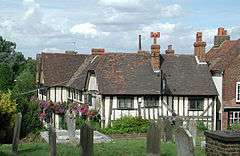Cobham, Kent
Cobham (/ˈkɒbəm/[2]) is a village and civil parish[3] in the borough of Gravesham in Kent, England. The village is located 6 miles (10 km) south-east of Gravesend, and just south of Watling Street, the Roman road from Dover to London. The parish, which includes the hamlet of Sole Street, covers an area of 1,240 hectares (3,100 acres) and had a population of 1,469 at the 2011 Census,[1] increasing from 1,328 at the 2001 Census.
| Cobham | |
|---|---|
 Public House, Cobham, Kent | |
 Cobham Location within Kent | |
| Population | 1,469 (2011)[1] |
| OS grid reference | TQ671683 |
| Civil parish |
|
| District | |
| Shire county | |
| Region | |
| Country | England |
| Sovereign state | United Kingdom |
| Post town | GRAVESEND |
| Postcode district | DA12, DA13 |
| Dialling code | 01474 |
| Police | Kent |
| Fire | Kent |
| Ambulance | South East Coast |
| UK Parliament | |
The village is in a Conservation Area[4] and as such remains relatively unspoilt. The parish church is 13th century and is dedicated to St Mary Magdalene,[5] and has monumental brasses which are reputedly the finest in England. William Belcher in his Kentish Brasses (1905) stated: Kent is peculiarly rich in Brasses. It has, perhaps, a larger number and a more representative collection than any other county, although individually finer examples may be found elsewhere. No church in the world possesses such a splendid series as the nineteen brasses in Cobham Church, ranging in date between 1298 and 1529.[6] Thirteen of the brasses belong to the years 1320–1529 and commemorate members of the Brooke and Cobham families.[7] The church in Luddesdown, part of the ecclesiastical parish, is dedicated to St Peter and St Paul. Next to the church in the village is Cobham College, a one-time home for secular priests, and now acting as almshouses.
Cobham does not appear as a separate manor in the Domesday Book,[8] so the village and parish were probably established later than 1086. The Cobham family was established here before the reign of King John[7] (who reigned from 1199). Cobham Parish was originally in the ancient hundred of Shamwell.[9]
Cobham Hall[10] was the former 17th-century home of the Earls of Darnley: its gardens were designed by Humphry Repton and the surrounding woods contain the Darnley Mausoleum, a Grade I listed building. The Earls of Darnley left in 1957, and since 1962, the Hall has been a public school for girls (Cobham Hall School); it opens to the public on some occasions in the year.
In addition to Cobham Hall, there is a local primary school - Cobham Primary School. It is very difficult to be admitted due to the small class size. It is a big feature of the village, often tying together many of the locals.
There are two areas of open space in the parish: Cobham Park,[11] which includes extensive woodlands; and Jeskyns, a one-time farm of 360 acres (147 ha), which has been turned into a greenspace area by the Forestry Commission.
Cobham has strong links with Charles Dickens, who used to walk out to the village: he set part of The Pickwick Papers there. Other personalities connected with Cobham include Sir Joseph Williamson, and the insane artist Richard Dadd, who murdered his father near here in 1843. The Hon Ivo Bligh, who became the 8th Earl of Darnley, was the first English cricket captain to attempt to recover The Ashes from Australia in the late 19th century. Comedian Joe Pasquale lives in the area and owns land adjoining the estate of Cobham Hall.
The village was also linked to its namesake HMS Cobham, a Ham-class minesweeper which was an active Royal Navy vessel between 1953 and 1966.[12]
Transport
Cobham is served by Sole Street railway station, on the Chatham main line which runs from Gillingham to London Victoria via Bromley South.
Historic estates
References
- "Parish population 2011". Neighbourhood Statistics. Office for National Statistics. Retrieved 30 September 2015.
- Jones, Daniel (2003) [1917]. Collins, Beverley; Mees, Inger M. (eds.). An English Pronouncing Dictionary. Daniel Jones: Selected Works. Volume 3. Routledge. p. 70. ISBN 9780415233392.
- "Cobham Parish Council (Kent)". Cobham Parish Council (Kent).
- "Conservation Area Appraisal" (PDF). Archived from the original (PDF) on 9 June 2011. Retrieved 6 November 2007.
- "Cobham and Luddesdowne". www.cobham-luddesdowne.org.
- William Belcher, Kentish Brasses, Preface, Vol.2
- Chisholm, Hugh, ed. (1911). . Encyclopædia Britannica. 6 (11th ed.). Cambridge University Press. p. 612.
- Open Domesday Online: Cobham, Kent area, accessed April 2017.
- Vision of Britain: Cobham Parish, accessed April 2017
- Reserved, Gravesham Borough Council - All Rights (1 January 2016). "Home". www.gravesham.gov.uk. Archived from the original on 3 November 2005. Retrieved 8 November 2005.
- "Cobham Park Heritage Project". www.cobhampark.org.uk. Archived from the original on 5 July 2008.
- Blackman, R.V.B. ed. Jane's Fighting Ships (1953)
